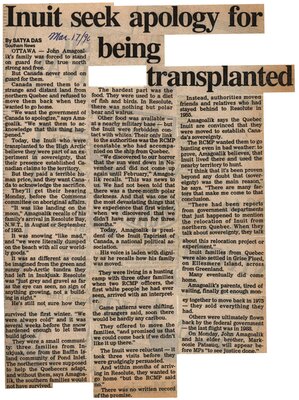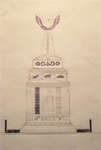"Inuit Seek Apology For Being Transplanted
- Full Text
- Inuit seek apology for being transplantedBy SATYA DAS, Southam News
OTTAWA - John Amagoalik's family was forced to stand on guard for the true north strong and free.
But Canada never stood on guard for them.
Canada moved them to a strange and distant land from northern Quebec and refused to move them back when they wanted to go home.
"We want the government of Canada to apologize," says Amagoalik. "We want them to acknowledge that this thing happened."
Today, the Inuit who were transplanted to the High Arctic believe they were part of an experiment in sovereignty, that their presence established Canadian claims to the territory.
But they paid a terrible human price, and they want Canada to acknowledge the sacrifice.
They'll get their hearing Monday, before the Commons committee on aboriginal affairs.
"It was like landing on the moon," Amagoalik recalls of his family's arrival in Resolute Bay, N.W.T., in August or September of 1953.
It was snowing "like mad," and "we were literally dumped on the beach with all our worldly goods."
It was as different as could be imagined from the green and sunny sub-Arctic tundra they had left in Inukjuak. Resolute was "just grey and gravel as far as the eye can seen, no sign of anything growing, not a building in sight."
He's still not sure how they survived the first winter. "We were always cold" and it was several weeks before the snow hardened enough to let them build igloos.
They were a small community: three families from Inukjuak, one from the Baffin Island community of Pond Inlet. The northerners were supposed to help the Quebecers adapt, and without them, says Amagoalik, the southern families would not have survived.
The hardest part was the food. They were used to a diet of fish and birds. In Resolute, there was nothing but polar bear and walrus.
Other food was available - at a nearby military base - but the Inuit were forbidden contact with whites. Their only link to the authorities was the RCMP constable who had accompanied on the ship from Quebec.
"We discovered to our horror that the sun went down in November and did not come up again until February," Amagoalik recalls. "This was news to us. We had not been told that there was a three month polar darkness. And that was one of the most devastating things that we experience that first winter, when we discovered that we didn't have any sun for three months."
Today, Amagoalik is president of the Inuit Tapirisat of Canada, a national political association.
His voice is laden with dignity as he recalls how his family was moved.
They were living in a hunting camp with three other families when two RCMP officers, the first white people he had ever seen, arrived with an interpreter.
Game patterns were shifting, the strangers said, soon there would be hardly any caribou.
They offered to move the families, "and promised us that we could come back if we didn't like it up there."
The Inuit were reluctant - it took three visits before they were grudgingly persuaded.
And within months of arriving in Resolute, they wanted to go home "but the RCMP said no."
There was no written record of the promise.
Instead, authorities moved friends and relatives who had stayed behind to Resolute in 1955.
Amagoalik says the Quebec Inuit are convinced that they were moved to establish Canada's sovereignty.
The RCMP wanted them to go hunting even in bad weather: to prove, Amagoalik believes, that Inuit lived there and used the nearby territory to hunt.
"I think that it's been proven beyond any doubt that (sovereignty) was the main reason," he says. "There are many factors that make me come to that conclusion.
"There had been reports from government departments that just happened to mention the relocation of Inuit from northern Quebec. When they talk about sovereignty, they talk about this relocation project or experiment."
Inuit families from Quebec were also settled in Grise Fiord, on Ellesmere Island, across from Greenland.
Many eventually did come home.
Amagoalik's parents, tired of waiting, finally got enough money together to move back in 1975 - they sold everything they had.
Others were ultimately flown back by the federal government - the last flight was in 1988.
On Monday, John Amagoalik and his elder brother, Markoosie Patsauq, will appear before MPs "to see justice done."
- Creator
- Das, Satya, Author
- Media Type
- Newspaper
- Item Types
- Articles
- Clippings
- Description
- "John Amagoalik's family was forced to stand on guard for the true north strong and free. But Canada never stood on guard for them. Canada moved them to a strange and distant land from northern Quebec and refused to move them back when they wanted to go home."
- Date of Original
- Winter 1990
- Subject(s)
- Personal Name(s)
- Amagoalik, John ; Patsauq, Markoosie.
- Local identifier
- SNPL001341v00d
- Collection
- Scrapbook #2
- Language of Item
- English
- Creative Commons licence
 [more details]
[more details]- Copyright Statement
- Public domain: Copyright has expired according to Canadian law. No restrictions on use.
- Copyright Date
- 1990
- Copyright Holder
- Southam News
- Contact
- Six Nations Public LibraryEmail:info@snpl.ca
Website:
Agency street/mail address:1679 Chiefswood Rd
PO Box 149
Ohsweken, ON N0A 1M0
519-445-2954



